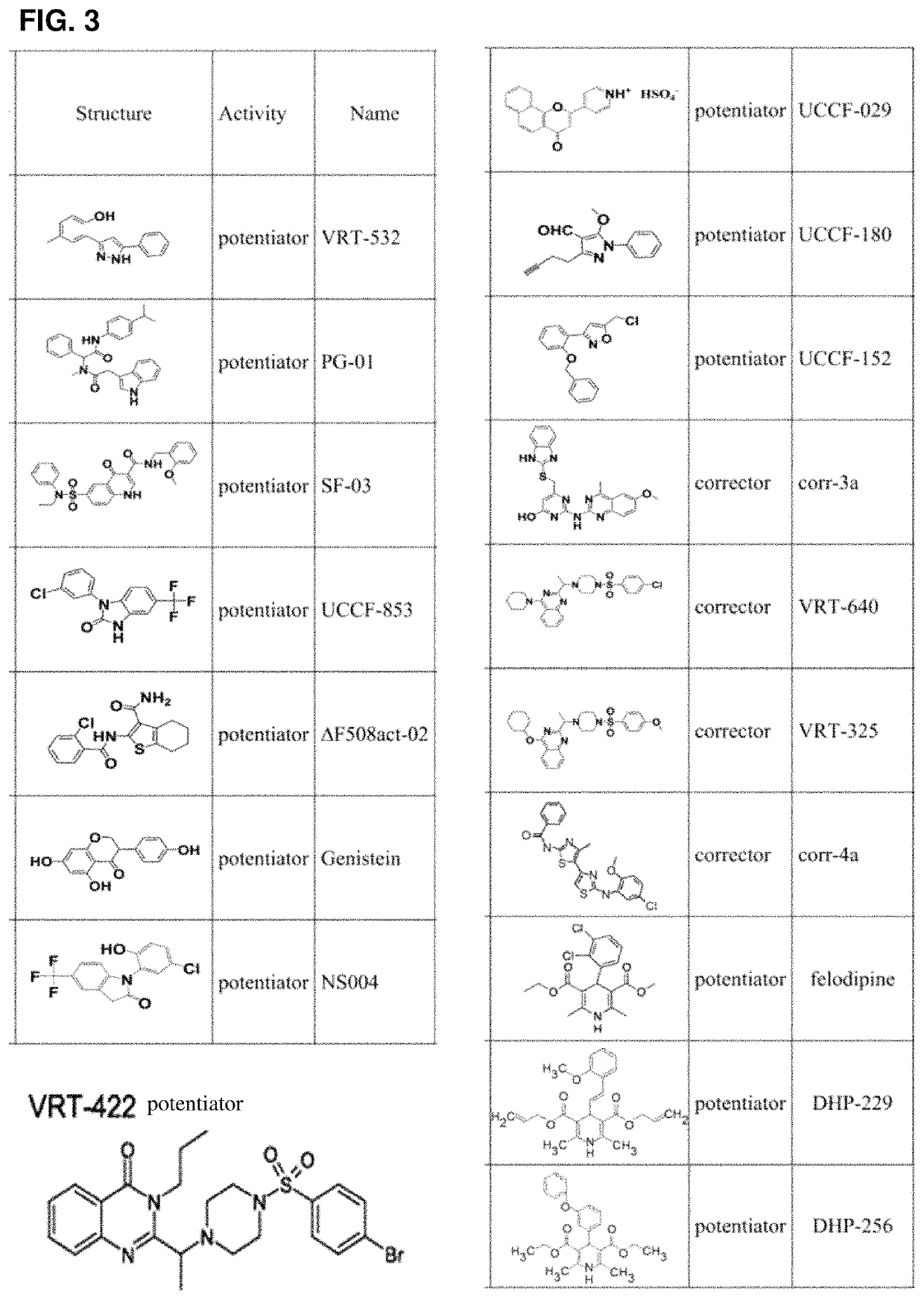Use of aliginate oligomers and CFTR modulators in treatment of conditions associated with CFTR dysfunction
a technology of cftr and modulator, which is applied in the direction of heterocyclic compound active ingredients, organic active ingredients, drug compositions, etc., can solve the problems of cftr (ion channel) dysfunction, poor quality of life but also morbidity and mortality, and the plethora of clinical conditions associated not only. , to achieve the effect of improving the effectiveness of cftr modulators, improving clinical efficacy, and effective, safer or convenient routes of administration
- Summary
- Abstract
- Description
- Claims
- Application Information
AI Technical Summary
Benefits of technology
Problems solved by technology
Method used
Image
Examples
example 1
[0265]A patient previously diagnosed with CF is identified and consent for therapeutic treatment is obtained. A film-coated tablet containing 150 mg ivacaftor, the inactive ingredients colloidal silicon dioxide, croscarmellose sodium, hypromellose acetate succinate, lactose monohydrate, magnesium stearate, microcrystalline cellulose, and sodium lauryl sulphate, and a film of carnauba wax, FD&C Blue #2, PEG 3350, polyvinyl alcohol, talc, and titanium dioxide is administered to the patient twice a day for at least 48 weeks. An inhalable powder containing 80% OligoG CF 5 / 20 (5-20mer alginate oligomer with at least 85% G residues) and 20% of other DPI excipients is also administered to the patient via a DPI inhaler twice daily resulting in a total daily dose of 2 g. The patient's clinical indicators of CF are observed, including their forced expiratory volume in 1 second (FEV1) and sweat chloride levels.
example 2
[0266]Patients previously diagnosed with CF are identified and consent for therapeutic treatment is obtained. A film-coated tablet containing 25 mg, 50 mg, 100 mg, 200 mg, 250 mg, 400 mg or 600 mg lumacaftor, the inactive ingredients colloidal silicon dioxide, croscarmellose sodium, hypromellose acetate succinate, lactose monohydrate, magnesium stearate, microcrystalline cellulose, and sodium lauryl sulphate, and a film of carnauba wax, FD&C Blue #2, PEG 3350, polyvinyl alcohol, talc, and titanium dioxide is administered to each patient twice a day for at least 28 days. An inhalable powder containing 80% OligoG CF 5 / 20 (5-20mer alginate oligomer with at least 85% G residues) and 20% of other DPI excipients is also administered to the patient via a DPI inhaler twice daily resulting in a total daily dose of 2 g. The patients' clinical indicators of CF are observed, including their forced expiratory volume in 1 second (FEV1) and sweat chloride levels.
example 3
[0267]Patients previously diagnosed with CF are identified and consent for therapeutic treatment is obtained. Powdered ataluren is administered in water or milk three times a day (at breakfast, lunch and dinner) over a period of at least 48 weeks. Amounts administered are as follows: (i) 4 mg / kg at breakfast, 4 mg / kg at lunch, 8 mg / kg at dinner; or (ii) 10 mg / kg at breakfast, 10 mg / kg at lunch, 20 mg / kg at dinner. Two enteric coated tablets containing 80% w / v of OligoG CF 5 / 20 oligomer and 20% of other excipients are also administered to the patient orally twice daily resulting in a total daily dose of 2 g. The patient's clinical indicators of CF are observed, including their sweat chloride levels and gut transit times.
PUM
| Property | Measurement | Unit |
|---|---|---|
| molecular weight | aaaaa | aaaaa |
| molecular weight | aaaaa | aaaaa |
| molecular weight | aaaaa | aaaaa |
Abstract
Description
Claims
Application Information
 Login to View More
Login to View More - R&D
- Intellectual Property
- Life Sciences
- Materials
- Tech Scout
- Unparalleled Data Quality
- Higher Quality Content
- 60% Fewer Hallucinations
Browse by: Latest US Patents, China's latest patents, Technical Efficacy Thesaurus, Application Domain, Technology Topic, Popular Technical Reports.
© 2025 PatSnap. All rights reserved.Legal|Privacy policy|Modern Slavery Act Transparency Statement|Sitemap|About US| Contact US: help@patsnap.com



